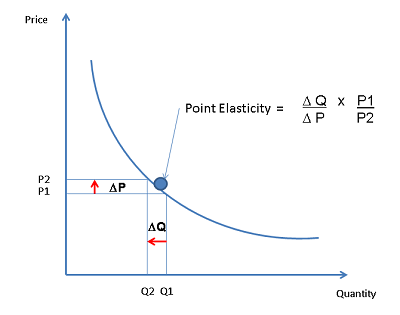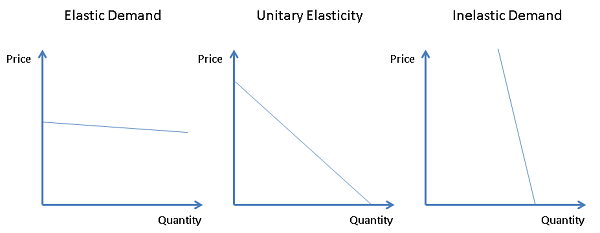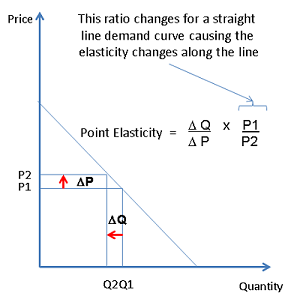Our economics tutors at GraduateTutor.com tutor students in elasticity from a range of text books and so cover the different angles that elasticity can be viewed at or understood from. Here is a brief look at the different angles on elasticity.
- What is Elasticity?
- Are there different types of Elasticity?
- How is Elasticity measured?
- Why is Elasticity negative?
- What are the different degrees of Elasticity?
- What insight does Elasticity give about revenues?
- Short and long term Elasticity
- What factors affect Elasticity
- Pricing and Elasticity
What is Elasticity?
Elasticity in economics essentially captures how one economic variable responds to changes in another. Or, in other words, elasticity captures how sensitive one variable is to changes in another variable. There are a whole range of definitions for elasticity, but this is basically it – how a change in one factor; perhaps an increase or a decrease, will affect and increase or decrease another.
(We distinguish between a shift of the demand curve vs move along the demand curve when studying the demand and supply dynamics in economics. Elasticity can be said to be quantifying the movement along the demand curve.)
Can You Have Different Types of Elasticity?
Elasticity could cover a whole range of variables like price, demand, supply, income, expenditure and so on. When the elasticity variables are not specified, it is generally assumed that one is talking about price elasticity of demand which is the changes in quantity demanded in response to changes in price of that good holding other factors constant.
Managers often want to understand how the demand for a product will change if the price of a related good changes. This is defined as cross price elasticity and measures the change in quantity demanded of a product given a change in a related good. The related good can be a complement or a substitute or a competing good.
Income elasticity is another commonly used type of elasticity. Income elasticity measures the changes in quantity demanded by changes in income holding other factors constant.
Elasticity can also be categorized as long term elasticity and short term elasticity. We will cover long term elasticity and short term elasticity later in this article.
How is Elasticity Measured?
Measuring elasticity is frightfully simple. The percentage change in quantity demanded by a percentage change in price gives the price elasticity coefficient Ep (simply called price elasticity):
Elasticity (price) = % change in quantity
% change in price
The percentage change in quantity is arrived at by dividing the unit change in quantity due to the price change by the total quantity before the price change. And the percentage change in price is arrived at by dividing the dollar change in price by the initial price.
Unit of Elasticity
Elasticity is a ratio of two numbers and is therefore a unit-less measure. This makes it possible to compare and contrast elasticity of different products or the same product across countries.
Types of Elasticity: Point Elasticity
Elasticity can be measured in two ways. Point elasticity would be the price elasticity of demand at a certain point on the demand curve. When price increases by a small amount from P1 to P2 in the demand curve above, we see that the quantity demanded decreases from Q1 to Q2. The elasticity at this point on the demand curve according to the formula is: Ep = ∆Q/∆P x P1/Q1
An Alternate Formula for Point Elasticity
There is an alternate formula for computing point elasticity. This formula is the mathematical equivalent of the above point elasticity formula and so will result in exactly the same point elasticity value. 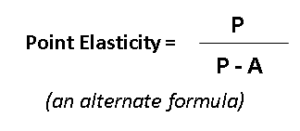
Types of Elasticity: Arc(h) Elasticity
Arch elasticity would be point elasticity …….. shown over a whole range of prices. This is the elasticity between any two points on the demand curve. 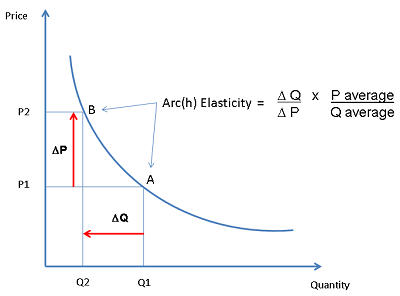
Degrees of Elasticity – Elastic, Inelastic or Unitary elastic
The absolute value of elasticity provides plenty of insight. The absolute value of elasticity, for those who need a refresher, is simply the elasticity without the negative sign.
If │ Ep│>1, then demand is said to be elastic. When demand is said to be elastic, a percentage increase (decrease) in price leads to a larger percentage decrease (increase) in quantity demanded. Perfectly elastic demand would be a flat demand curve and indicates that a small change in price leads to a complete drop-off in demand. When we say elastic it usually means a relatively elastic demand curve where a change in price has a larger change (not a complete drop off) in demand.
If │ Ep│<1, then demand is said to be inelastic. When demand is said to be inelastic, a percentage increase (decrease) in price leads to a lower percentage decrease (increase) in quantity demanded. Perfectly inelastic demand would be a vertical demand curve and indicates that any change in price does not lead to a change in demand. When we say inelastic it usually means a relatively inelastic demand curve where a change in price has a small change (as opposed to no change) in demand.
If │ Ep│=1, the demand is said to be unitary elastic. When demand is said to be unitary, a percentage increase (decrease) in price leads to exactly the same percentage decrease (increase) in quantity demanded.
Elasticity and Total Revenue
Understanding elasticity can help managers understand the impact of price changes on the revenues of a company because elasticity measures the relationship between quantity demanded and price. These two variables, quantity demanded and price, determine revenues:
Revenues = Quantity Demanded * Price
When price increases (decreases) we know the quantity demanded for a normal good decreases (increases). How would revenues change when one of the two variables decreases and the other increases or vice versa? The total impact on revenue would depend on whether the price impact or the quantity impact is more powerful. Understanding elasticity can answer this question:
Will my revenues go up or down if I increase prices?
When the demand curve is elastic, an increase in the price causes the quantity impact (decrease in demand for a normal good) to be more powerful than the price impact leading to a drop in revenues. Similarly, when the demand curve is elastic, a decrease in the price causes the quantity impact to be more powerful (increase in demand for a normal good) than the price impact causing an increase in revenues.
When the demand curve is inelastic, an increase in the price causes the quantity impact to be less powerful than the price impact leading to an increase in revenues. Similarly, a decrease in the price causes the quantity impact to be less powerful than the price impact which leads to a decrease in revenues.

Short and Long Term Elasticity
Elasticity of a product varies when different time periods are considered. This is because when we measure elasticity, we need to measure the quantity demanded over a period of time. And the quantity demanded over a period of time will be different depending on whether the period is short term or long term.
This is very important to understand and distinguish because the consumption or demand for some products can more easily be changed whereas the consumption or demand for some products takes much longer to change in response to a change in price. For example, if 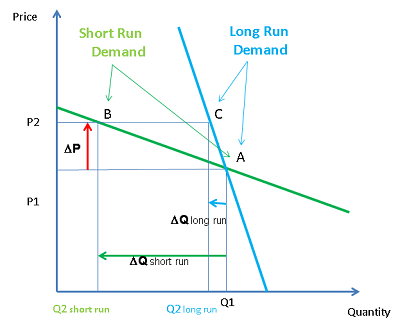
What constitutes short term and what constitutes long term depends on the time period in which the customers can completely adjust purchase decisions or demand to the changes in prices. Therefore the short term period may be weeks for a product like pizza but the short term may be months or years for a product like gasoline cars.
The nature of the product, consumption patterns, durability, etc determine if demand is more price elastic in the long run than in the short turn. For some goods (like coffee, gasoline, etc) demand is more price elastic in the long run than in the short turn because it takes time to change the purchase and consumption patterns. For some goods (like cars, TVs etc) the demand is more price elastic in the short run than in the long run.
Is Elasticity constant?
On a linear demand curve (straight line) elasticity will be different at all the points on the curve. A constant slope would ensure that the elasticity will be anything but constant, because the percentage change and ratio will be different given the changes in the numerator and denominator base values.
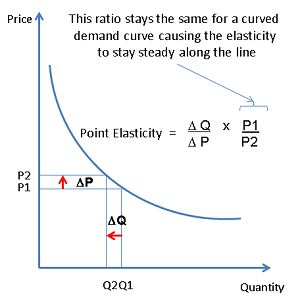
So what are the Factors that affect elasticity?
Why does our demand for certain goods change dramatically and why does it not change for some products? The reasons are pretty simple, but they do make an impact on whether we want to buy or not at various price points.
The Actual Nature of the Product
If the product is a necessity for me, then I will buy no matter what the price is. So essential goods like food grains and vegetables and especially medicines will be on my shopping list no matter the price because I absolutely cannot do without them. I may reduce the quantity if the price goes through the roof, but then again…..that’s a maybe. So the demand for these goods are more inelastic in nature.
When the product is something of a general comfort good to me, like high- end TV or gourmet ice cream, something that improves my well-being but is not an absolute necessity, I would look at the price and buy it if I think it’s reasonable or maybe leave it for a time when I think it will be. The demand of these goods are generally more elastic in nature.
A quick note must be added that my necessity or luxury need not be the same for someone else.
The Availability Substitutes
A second factor that affects elasticity big time would be the availability of substitutes or alternate options. I go back to the very easy-to-understand option of fast food. If my fried chicken is looking pricey, I hop over to pizza or vice versa. The more options I have available at my fingertips for a certain type of product, and the closer the substitutes are in nature, eg: Pepsi and Coke ; the more elastic its demand is bound to be.
Here, there must also be a mention of market elasticity versus brand elasticity. Sometimes the market elasticity of a product, say, cigarettes is relatively inelastic. If, however the price of one brand goes up, consumers tend to drop that brand and switch to the cheaper ones. Thus while there is inelastic market demand; the brand elasticity is quite high.
Income Levels of Consumers
Consumers with a high level of income are not inclined to cut down consumption or expenditure owing to a rise or change in prices. That will be however be different for consumers with lower or average income levels with the necessity to budget expenses carefully. Thus the sensitivity of demand to changes in price will also be a function of the income levels in the market.
Possibility of Postponement of Consumption.
If I can put away the use of a certain product then its demand would be highly elastic (at least in the short term) as I can postpone the purchase of the good easily. For example, I can postpone the purchase of a car or a washing machine if the price has risen. This however would not be the case for tooth paste or of a lifesaving drug. Demand for these products is inelastic.
Number of Uses
Let us take the example of electricity. I use electricity for a lot of things, but if my meter was going crazy and giving me enormous bills, I would take a look at the things that I used electricity for and use it only for essentials. So I would do the dishes after dinner and give the dishwasher a rest. I would cut down on the air conditioning and switch to fans when the weather became cooler. The demand for electricity is elastic, against a product which had only a specific use, or maybe a few specific uses. Thus more uses make a product’s demand more elastic.
Share of Wallet
If a large chunk of my income is going to be spent on a certain item then the demand for it is going to be elastic as I spend considerable time and effort thinking about mitigating expenses when price increases. For example the demand of a car will be elastic as it is a major expenditure for an average family. An item on which expenditure is not going to be a major drain will have a relatively inelastic demand as I don’t bother with it. For example, the price variations in the price of a needle or a matchbox are not going to affect the demand.
Time period
Short periods of time induce little or no elasticity. Over a period, elasticity could be found to be highly elastic as more options find their way in as it gives consumers ample time to look at, switch over to and adjust to other options thus making demand highly elastic. This is so because in the short run other options are limited and cannot be arranged at short notice.
Habit
Goods that have become a habit or maybe even an addiction swing over to the list of necessities and hence become inelastic in their demand. Alcohol, tobacco, coffee and cigarettes fall into this category. No matter what the level of scarcity or price rise the demand is not likely to be altered.
Income Elasticity And Type Of Good (Normal vs. Inferior)
Income Elasticity is helpful in classifying a product or service as a normal good versus an inferior good. If a product’s income elasticity of demand is positive, the product is considered a normal good. If a product’s income elasticity of demand is positive it indicates that the higher the income the more the demand for the product which fits the definition of a normal good. Similarly, if a product’s income elasticity of demand is negative, the product is considered an inferior good. If a product’s income elasticity of demand is negative it indicates that the higher the income the lower the demand for the product will be which fits the definition of an inferior good.
Elasticity and Pricing
Pricing a product is a significant challenge for managers. Elasticity of the product plays an important role in the pricing of a product. For example, if you are a monopolist, you will maximize your profit when your mark up on your product is the inverse of your product’s elasticity.
Different market conditions will need different elasticity-pricing rules. For example, if you are in a perfectly competitive market you cannot decide your product’s price because the moment you increase your price, your sales will drop to zero reflecting a perfectly elastic setting.
Understanding Elasticity
Elasticity is a topic every single MBA student will encounter in economics. It is a beautiful and multidimensional concept with applications across disciplines including finance, marketing, pricing and strategy. As it is a multi-dimensional topic, there are many ways to look at elasticity. This often confuses students or hinders a full understanding of elasticity. In fact many text books cover only some of these perspectives on elasticity.
If you have questions or need help understanding elasticity, please feel free to call our economics tutoring team and we will be happy to assist you.
Note: Elasticity is used in the production / cost side of economics too. This is not covered in this article.
